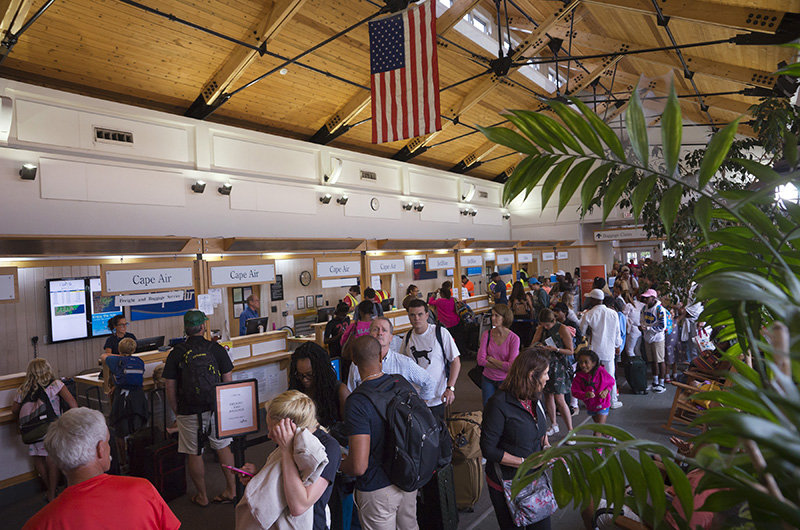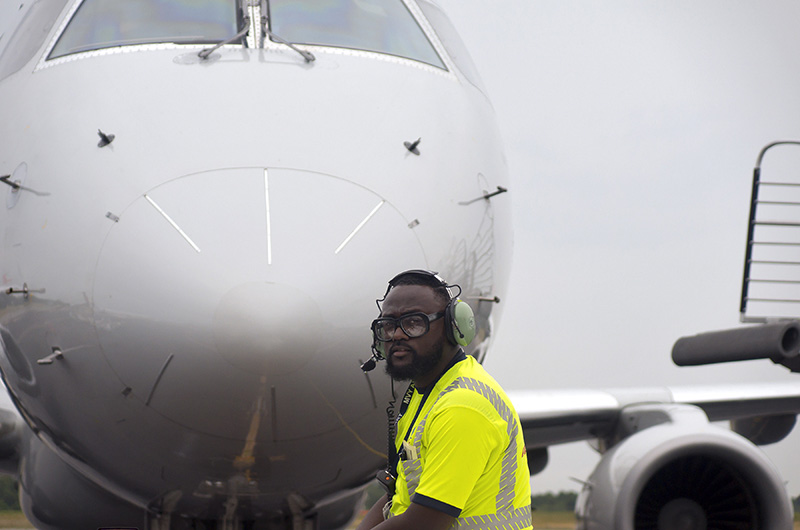The Martha’s Vineyard Airport is seeking preliminary federal funding for a major $39 million redevelopment and expansion plan at the main terminal, despite a steep decline in air traffic since the last terminal was built.
Airport manager Ann Richart told the airport commission at its meeting last Thursday that she has applied for some $6 million to cover phase one design and permitting costs for a project that would double the airport terminal to some 32,000 square feet, create more space for passengers and baggage handling and allow more airlines to service the Island.

Ms. Richart said the grant money would come from a $1 billion Federal Aviation Administration omnibus spending bill approved in April for small airports and their infrastructure projects. The FAA is the clearinghouse for the funding. The time frame for grant awards runs for three years starting this September.
If the $6 million is approved, Ms. Richart said the airport would then apply for some $33.7 million in construction money. Calling the omnibus bill a “golden egg,” Ms. Richart told commissioners: “We have the opportunity to do this now. If we get this grant, building a new terminal building is exciting, but also a lot of work. We have our work cut out for us.”
The proposal comes against a backdrop of steadily declining air traffic over the past two decades at the Island’s only commercial airport. It is also a major deviation from the airport’s own master plan, updated in 2016, which set out an eight-year, $18 million capital improvement plan for the airport, only $3.4 million of which involved terminal improvements.
Speaking to the Gazette by telephone on Monday, Ms. Richart said the spending bill passed in the spring but details on the application process only became available in early July. She said the application was due August 8, so she was forced to act quickly.
“The very quick timeline and letter of intent doesn’t obligate us for anything,” Ms. Richart said. “We probably have a 50/50 chance at best of getting this.”
She said airport commissioners have not voted on any plans.
“If the FAA looks like it wants to give us a grant, then the commission will really deliberate and decide if they want to go forward,” she said.
At 15,000 square feet, the current terminal is about half the size of the one under consideration. The existing terminal, a decade in the planning, opened with fanfare in June 1999, replacing a structure originally constructed as a U.S. Navy base in World War II. The terminal cost about $11 million at the time.
The year after the new terminal was built, the airport reached its peak traffic, as measured both by the number of takeoffs and landings and by passenger boardings, also known as enplanements. In calendar year 2000, a total of 66,154 planes landed or took off from MVY, accounting for just over 71,000 passengers.
Air traffic in and out of MVY declined steadily from then until about 2011 when the FAA recorded a 25-year low of fewer than 40,000 landings and takeoffs at the Island airport. Passenger boardings had reached a low ebb in 2009, at 42,248. Traffic has rebounded somewhat since then but has averaged less than 50,000 takeoffs and landings per year in the last five years. In 2017, there were 49,767 passenger boardings recorded, down eight per cent from the year before and 30 per cent less than in the peak year of 2000.
Monthly business reports prepared by Ms. Richart confirmed a downward trend this summer. In June, the latest available report, total enplanements year to date were 8,166, compared with 8,646 for the same period in 2017 — a drop of 5.6 per cent.
In the June report Ms. Richart also took note of summer congestion problems. “We continue to experience significant congestion at the airline ticket counters, baggage claim, security screening checkpoint, gate lobby, front curb, and entrance road during the peak airline flight times,” she wrote. “Looking forward to working with you on making improvements to the terminal area to relieve this overcrowding.”
According to FAA figures, about half the annual traffic to the Island occurs in June, July and August, a proportion that has remained largely unchanged through fluctuations in overall traffic.
The updated master plan, released in September 2016, attributed the decline in airport usage after 2000 to a combination of factors, including two economic recessions, the rising cost of air travel and competition from ferry services. “By comparison,” the plan says, “Steamship Authority ferry passenger traffic fluctuated within a narrow range between 2000 and 2013, particularly between 2003 and 2011, and did not experience the same decline as aircraft operations.”
After 2011, security requirements nationwide led to major changes at the airport that could not have been contemplated when the new terminal was built a decade earlier. TSA screening now occupies a large amount of space in the terminal.
The 2016 updated master plan outlined four options for terminal improvements ranging from a $100,000 plan to add a family restroom and purchase a tent to hold screened passengers prior to boarding during the summer months, to a $7.7 million plan to gut and reconfigure the restaurant, administrative offices and baggage claim areas. In the end the plan settled on a $3.4 million option that would convert the rock garden area between the walkway and the terminal building to additional space in the main lobby, and add space to create a bigger baggage screening and secure holding area.
The grant funding application announced last week describes an array of planned improvements, including replacing the outdoor area that is tented with a permanent structure, revamping the baggage claim areas and correcting deficiencies on access roads in and out of the airport. It also paints a picture of an airport that is maxed out. “Currently the airport is over capacity for the number of passengers and baggage that can be handled at one time,” the application says.
“Although enplanements have increased and air carrier load factors are maximized, there is no longer room for airline ticketing counter; nor electrical subpanels for additional wall outlets to plug in computers. MVY cannot commit to airlines requesting route development at MVY due to limited infrastructure. This project will allow multiple domestic flights to operate simultaneously and increase route development opportunities.”
The application suggests that the expansion could bring increased revenue to the airport:
“MVY gains revenue through passenger facility charges, airline tenant leases and fuel sales to airlines. The increase in passengers assists the airport in attracting high lease rates for non-AIP eligible areas such as car rental facilities, restaurants and other concessions.”
Airport commissioners had little comment at the meeting.
But in a letter to the editor published online in the Gazette this week, airport commission chairman Robert Rosenbaum emphasized that any plan would need to be vetted first with Islanders. He also underscored the need for more space for TSA screening. “Screened passengers are herded into a tent, open on the sides to the weather with porta-potties. There is no air conditioning or heat. Passengers have missed flights because of delays going through the single security line,” he wrote.
“The airport commission and management are attempting to make the experience of passengers arriving and departing on commercial flights a pleasant one as well as for the family and friends they are picking them up. We are all Island residents and are all very familiar with all the challenges we are facing.”








Comments (64)
Pages
Comments
Comment policy »